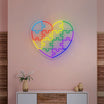Table of Contents
Are you looking to purchase LED light strips for your home or commercial space? In this article, we cover everything you need to know about them and offer valuable tips on using them. This is a beginner’s guide to LED strip lights explaining everything from basics like types of LED strip lights to complex but simplified topics like power supply and voltage requirements.
LED strip lights are currently very popular for use in all kinds of places including homes, office spaces, and commercial floors. According to a recent survey by the Residential Energy Consumption Survey (RECS), LED as a technology is taking over in many applications with over 47% of households in the USA reporting switching to some form of LED lighting in recent years RECS. You’ll, therefore be making the right choice investing in LED strip lights.

What Are LED Strip Lights?
LED strip lights are flexible circuit boards with surface-mounted LEDs (light-emitting diodes) Spruce. Their flexibility makes them easy to install in all kinds of configurations. These strip light consists of a flexible base material which is mainly a printed circuit board or PCB in short. The PCB usually contains a series of LED chips which are mounted along its length for continuous and adaptable illumination.
An LED strip light contains five main components. These components are a PCB substrate, LED chips, a protective coating or a silicon sleeve that provides waterproofing, some copper connection points, and an adhesive backing which you can use to mount the strip on various surfaces.
Most LED strip light models also come with a standardized connector you can use to power them on with a power supply or a transformer. The transformer or power supply needs to be compatible with the standard connector. It converts your household or building electricity to low-voltage direct current for the LED strip lights to work.
Types of LED Strip Lights
There are different types of LED strip lights each designed to serve a specific purpose or be used in a certain way. Examples include single-color, RGB, and addressable. The following is a description of each of the main types:

Single Color LED Strip Lights
Single-color LED strip lights are the most basic in terms of design and how they work. They feature a uniform color output as the name suggests which is normally white, warm white, or specific hues like red or blue. In terms of functionality, single-color LED strip lights emit consistent light coming from all the light-emitting diodes (LEDs) at the same time.
Single-color LED light strips are best used for standard lighting applications although they can be used for decorative purposes if different hues and colors are combined in one space. Examples of common applications for single-color LED strips include under-cabinet illumination, creating ambiance, and accent lighting.
These are the most affordable LED strip lights as well because of their simple design. You can also get them in various colors or temperatures depending on your lighting needs. These sub-types include cool, warm, and bright-colored temperature LED strips.
Multi-Color LED Strip Lights
As the naming may suggest multi-color LED strip lights combine several colors and hues in a single light strip for more versatility. They include multiple lighting-emitting abilities with RGB (Red, Green, and Blue) being the standard configuration. You can create virtually any color combination with multi-color RGB combinations when you mix the three primary colors and use varying intensities.
There are more advanced variants of these multi-color LED light strips offering more versatility and even more color coding. These include RGBW -adding the color white to the primary colors- and RGBWW- which adds a warmer white to the RGBW configuration. These advanced multi-color LED strips are the best if you want to configure more colors and tone for example when creating mood lighting in a room.
Most multi-color LED strips either come with a remote control or a smartphone app or both for easier control and color configuration. You can use the remote or app to switch the LED strips on and make granular changes to colors, brightness, and hues to your liking. You can even set dynamic color-changing mode or activate preset mood lighting configurations to copy a certain theme like forest, movie, etc.
Addressable LED Strip Lights
Addressable are the most sophisticated type of LED strip lights. They allow you more control over lighting, colors, and hues through with granular controls over each individual LED.
They also use that functionality to control each LED individually which enables even more complex light shows, and patterns. Addressable LED strip lights can create pixel-like light effects because of their granularity.
Because you can control program each of the LEDs independently manual control allows you to create complex lighting configurations to show things like animations and gradients. Addressable LED strip lights use specialized communication protocols like SK6812 and WS2812B Instructables. Popular applications for addressable LED strip lights include creative installations, movie setups, gaming setups, and advertisement setups.
Main Purposes of LED Strip Lights
The following are some of the main purposes of applications of LED strip lights in residential, commercial, and industrial settings:

Ambient/Decorative Lighting
One of the main purposes of LED strip lights in all settings is ambient or decorative lighting. Here, they are used to create atmospheric and decorative illumination. You can use LED strip lights to add a modern to any interior space using light to highlight architectural features or adding soft backgrounds.
Another option is to use multi-color strip lights to create unique visual effects in a room for decorative purposes.
Mood Setting and Aesthetic Enhancement
LED strip lights have advanced color capabilities which allows them to be used to set mood or atmospheric environment. For example, in an entertainment space, the LED strips can be set up to change and combine colors to match a movie. You can also use the dynamic setting features in companion apps to create lighting scenarios for every mood.
Navigation and Safety
LED strip lighting can be used to provide energy-efficient safety and navigation lighting in critical areas like staircases. The low guidance lighting also has applications in places like kitchen cabinets, home theatre setups, and such. The subtle lights improve safety wherever it is placed without being too disruptive or harsh. Because LED strip lights emit little to no heat, they are best suited for installation in tight spaces.
Use in Commercial and Retail Settings
LED strip lights enjoy heavy use in commercial and retail spaces where they are used for branding, advertising product lighting, and creating ambient lighting environments for customers. Other applications in commercial spaces include restaurant mood lighting settings, and creating showroom accents, Offices can also be enhanced visually with LED light strips that create well-lit and inviting spaces for everyone.
Frequently Asked Questions
Can I Put LED Light Strips in My Bathroom?
Yes, you can put LED light strips in your bathroom but look for moisture-resistant models when shopping. Use specifically rates water-resistant or water-sealed strips that have an IP67 or IP68 rating meant to indicate that they are protected against water splashes or immersion to a certain depth.
Can I Put LED Light Strips on My Ceiling?
Ceilings are the most popular locations to install LED strip lights for ambient and architectural enhancing purposes. You can install them as cove lighting, indirect and direct lighting behind the crown molding, and perimeter lighting.
Can You Cut LED Strip Lights?
Yes, most LED strip lights are designed to be modular meaning you can cut them. However, make sure you cut them at specifically marked intervals which could be after every three to six LEDs.
How to Choose LED Strip Lights
The following are some of the main factors to consider when choosing LED strip lights:
Brightness (Lumens)
Choose your desired light intensity by checking the lumens per meter for the LED strip. Higher lumens mean brighter light or more illumination.
Color Temperature
Make sure the color temperature which is expressed in Kelvins (K) is what you want for your functional and atmosphere lighting needs. For instance, warm white is between 2700 and 3000 Kelvins and it creates an ideal living/working environment.
LED Strip Length and Configuration
The LED strips available come in different lengths and configurations so choose according to your needs. Standard LED strips can be in reels of 5 meters and have cutting points at specific lengths. You can also use more connectors or extension cables to extend the strips if necessary.
Power and Voltage Requirements
The LED strips you buy must be compatible with your power supply or transformer. Standard voltages for LED strips range between 12V to 24V. Check the power supply’s wattage capacity and other factors like plug type too.
Installation tips and tricks
Here are some tips and tricks for installing LED strip lights:
- Always prepare the surface well before mounting the strips
- Use additional mounting tips for long strips if needed
- Use sharp scissors when cutting LED strip lights
- Make sure to test the LED strips before final installation
- Plan your power supply and connection points carefully to avoid voltage drop
Conclusion
This beginner’s guide all the important details you need to know about LED strip lights. From definition to types of LED strips and additional tips and tricks. LED strip lights are the most versatile, energy-efficient, and affordable types of lighting available today.
What’s more, remember you can customize your LED lights to fit all your needs and preferences. Make sure to head over to our customization tool and get custom neon signs with Lamomoneon to complement your LED strip light setup today.





















